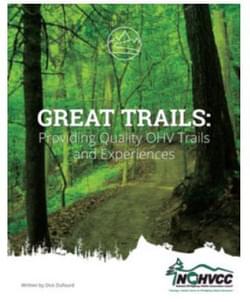




The definitive guide for the planning, designing, constructing, managing and maintaining Off-Highway Vehicle (OHV) trails
by National Off-Highway Vehicle Conservation Council (NOHVCC)

Great Trails: Providing Quality OHV Trails and Experiences is the definitive resource for planning, designing, constructing, maintaining, and managing Off-Highway Vehicle (OHV) recreational trails and trail systems. The primary audience for the guidebook is state and federal planners, trail managers, and land managers. Others who will find the publication invaluable include trail volunteers, OHV clubs and associations, and private land owners and trail managers.
In 2011 research by the National Off-Highway Vehicle Conservation Council (NOHVCC) concluded that the existing publications regarding OHV trail design, construction, and maintenance were outdated, did not include information about newer vehicle types, and didn’t include information about the latest design, construction, and maintenance techniques. Most of the material was created on the 1970s prior to the introduction of All-Terrain Vehicles (ATV). Several were updated in the 1990s prior to Recreational Off-Highway Vehicles (ROV or side by side).
We also discovered trail planners and managers were in desperate need of a source of information for specifying trail designs on public lands. Some managers were turning to the IMBA trail publications for trail specification on OHV trails. While the IMBA books are fantastic resources for planning and designing bicycle trails, the designs don’t account for the differences in vehicle size, weight, or the dynamics of motorized propulsion.
The theme of the book is “balancing the needs of the recreationists with protection of resources.” The book also helps land managers understand that trail planning, design, construction, maintenance, and management are not five separate processes but rather one continuous process referred to in the book as “the Great Trail Continuum.” Applying the “Great Trail Continuum” will result in trails that meet the user’s needs, are fun to ride, and are sustainable. The guide stresses the importance of providing trails for riders that are fun and challenging. The trail becomes the management tool because riders have trails “they want to ride,” not “trails they have to ride.”
Attached document published June 2016
Blackstone River Bikeway (2017)
posted Apr 19, 2024
The Blackstone River Bikeway is a 48-mile-long route connecting Worcester, Massachusetts with Providence, Rhode Island. The Bikeway generally follows the historic Blackstone River and utilizes an off-road multi-use path and an on-road facility.
posted Apr 17, 2024
This report summarizes guidance and best practices to create safer bicycle facilities and connect them into networks that allow more people to safely bike to more places within and throughout communities.
Wilderness Stewardship Plan Handbook
posted Mar 27, 2024
The purpose of the Wilderness Stewardship Plan Handbook 2014 is to provide direction for creating wilderness stewardship plans, driven by the concept of preserving wilderness character. The Handbook focuses on how to incorporate wilderness policy and wilderness character into a wilderness stewardship plan and also offers a general overview of planning and compliance to be useful for those with and without a professional background in planning.
Ice Age National Scenic Trail: Trail Stewardship Notebook
posted Mar 27, 2024
The Ice Age National Scenic Trail (NST) is a thousand-mile footpath highlighting Wisconsin’s renowned Ice Age heritage and scenic beauty. The Ice Age Trail Alliance (IATA) and its partners can shape users’ experiences. As stewards of the land and the Trail, we can help users develop a connection with the land and create a sense of wonder — even pique their curiosity enough to further explore the Trail.
2,825 views • posted 07/28/2020